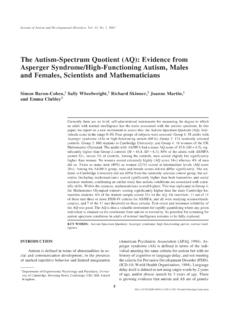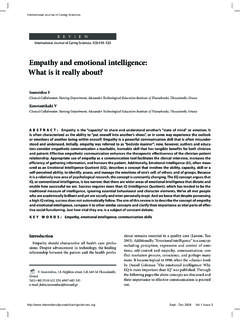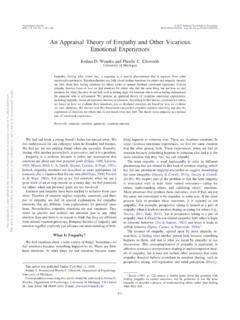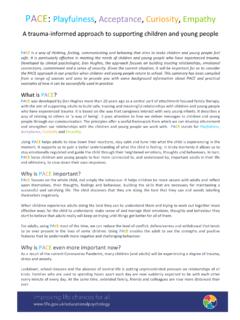Transcription of The Empathy Quotient: An Investigation of Adults with ...
1 0162-3257/04/0400-0163/0 2004 Plenum Publishing Corporation163 Journal of Autism and Developmental Disorders, Vol. 34, No. 2, April 2004 ( 2004)The Empathy Quotient: An Investigation of Adultswith Asperger Syndrome or High Functioning Autism,and Normal Sex DifferencesSimon Baron-Cohen1and Sally Wheelwright1 Empathy is an essential part of normal social functioning, yet there are precious few instrumentsfor measuring individual differences in this domain. In this article we review psychological the-ories of Empathy and its measurement. Previous instruments that purport to measure this havenot always focused purely on Empathy . We report a new self-report questionnaire, the EmpathyQuotient (EQ), for use with Adults of normal intelligence.
2 It contains 40 Empathy items and20 filler/control items. On each Empathy item a person can score 2, 1, or 0, so the EQ has a max-imum score of 80 and a minimum of zero. In Study 1 we employed the EQ with n =90 Adults (65 males, 25 females) with Asperger Syndrome (AS) or high-functioning autism (HFA), whoare reported clinically to have difficulties in Empathy . The Adults with AS/HFA scored signifi-cantly lower on the EQ than n =90 (65 males, 25 females) age-matched controls. Of the adultswith AS/HFA, 81% scored equal to or fewer than 30 points out of 80, compared with only 12%of controls. In Study 2 we carried out a study of n= 197 Adults from a general population, totest for previously reported sex differences (female superiority) in Empathy .
3 This confirmed thatwomen scored significantly higher than men. The EQ reveals both a sex difference in empathyin the general population and an Empathy deficit in WORDS: Empathy ; sex differences; Asperger syndrome; social Research Centre, Departments of Experimental Psychologyand Psychiatry, University of Cambridge, Douglas House, 18bTrumpington Rd., CB2 2AH, United is without question an important allows us to tune into how someone else is feeling,or what they might be thinking. Empathy allows us tounderstand the intentions of others, predict their be-havior, and experience an emotion triggered by theiremotion. In short, Empathy allows us to interact effec-tively in the social world.
4 It is also the glue of thesocial world, drawing us to help others and stopping usfrom hurting the term sympathy has a long tradition,the term Empathy astonishingly only came into beingat the turn of the last century. Astonishingly, becausewe believe that this ability is as old as Homo sapiensitself. No doubt Empathy itself has this long an evolu-tionary history, but the word Empathy was inventedby Titchener as a translation of the German word Einfuhlung, itself a term from aesthetics meaning toproject yourself into what you observe (Titchener,1909).Despite the obvious importance of Empathy , it isa difficult concept to define. Researchers in this areahave traditionally fallen into one of two camps: the-orists who have viewed Empathy in terms of affect,and those who have taken a more cognitive argue that both approaches are essential to defin-ing Empathy , and that in most instances, the cognitiveand affective cannot be easily separated.
5 Nevertheless,for historical reasons, we begin by examining each 3/18/04 21:33 Page 163164 Baron-Cohen and WheelwrightTHE AFFECTIVE APPROACHThe affective approach defines Empathy as an ob-server s emotional response to the affective state ofanother. This view of Empathy arose from writings onsympathy. Within the affective approach, different de-finitions of Empathy vary in how broad or narrow theobserver s emotional response to another s emotion hasto far as we can see, there are four varieties ofempathy: 1) the feeling in the observer must match thatof the person observed ( , you feel fright when yousee someone else s fear; Eisenberg & Miller, 1987;Hoffman, 1984); 2) The feeling in the observer is sim-ply appropriate to the other person s emotional state insome other way, even though it doesn t exactly matchit ( , you may feel pity at someone else s sadness;Stotland, 1969).
6 3) The feeling in the observer may beany emotional response to another s emotion ( , anobserver feeling pleasure at another s pain). This is re-ferred to as contrast Empathy (Stotland, Sherman, &Shaver, 1971). 4) The feeling in the observer must beone of concern or compassion to another s distress(Batson, 1991).Options 1, 2, and 4 all seem important to include,but need not be mutually exclusive. One can includeall of these in a useful definition of Empathy . However,option 3 seems questionable. We argue that empathyshould exclude inappropriate emotions triggered bysomeone else s emotional state ( , feeling pleasureat another s pain). Rather, the affective definition ofempathy emphasises the appropriateness of the viewer semotional response.
7 Of course, defining what is an ap-propriate emotional response is not straightforward. Forexample, hearing of the death of a young friend whohad been suffering from a painful, terminal illnessmight produce in you both relief (that their pain is over)and sadness (that their life has been cut short). Bothemotions are appropriate emotional responses and cantherefore be classified as empathic. (Note that if youfeel sadness at the loss of this friend, this may be un-related to Empathy , as it may be purely self-centred,albeit still appropriate. To count as Empathy , youremotion needs to be a consequence of their emotion.)THE COGNITIVE APPROACHC ognitive theories emphasize that Empathy in-volves understanding the other s feelings (Kohler,1929).
8 These theories also refer to cognitive processessuch as role-taking, switching attention to take another sperspective (Mead, 1934), or decentering ; that is, re-sponding nonegocentrically (Piaget, 1932). During the1940s and 1950s the term social acuity was also usedto refer to Empathy (Chapin, 1942; Dymond, 1950; Kerr& Speroff, 1954). In recent terminology, the cognitivecomponent is referred to as using a theory of mind (Astington, Harris, & Olson, 1988; Wellman, 1990) or mindreading (Baron-Cohen, 1995; Whiten, 1991). Es-sentially, this involves setting aside one s own currentperspective, attributing a mental state (or attitude ) tothe other person (Leslie, 1987), and then inferring thelikely content of their mental state, given the experienceof that some accounts these processes ap-pear purely cognitive in that there is no reference to anyaffective state.
9 For example, a person might infer thatbecause John was absent during a key event, he will notknow about it. In addition to this comprehension andinferential process, the cognitive element also entailsthe ability to predict another s behavior or mental state(Dennett, 1987). Thus, taking into account John signorance about a plan being changed can lead to theprediction that he will go to the wrong is clear from the above discussion that empa-thy consists of both the affective and cognitive com-ponents (Davis, 1994). A pictorial representation ofthe two-component model of Empathy is presented inFigure AND SYMPATHY: WHAT ISTHE RELATIONSHIP?In moral philosophy, Adam Smith described sym-pathy as the experience of fellow-feeling we havewhen we observe someone else s powerful emotionalstate (Smith, 1759).
10 Sympathy is therefore a clear in-stance of the affective component of Empathy . Sympa-thy is said to occur when the observer s emotionalresponse to the distress of another leads the observerto feel a desire to take action to alleviate the otherperson s suffering (Davis, 1994). The observer may notactually act on this desire, but at the very least theobserver has the emotion of wanting to take appropriateaction to reduce the other s distress. Thus, in Figure 1,sympathy is shown as a special subset of Empathy . (Weassume sympathy can entail both the cognitive andaffective elements of Empathy .)2A useful analogy here is to think of computers, where the user canswitch from the current window (their representation of theworld) to another window (someone else s different representationof the world).











